The Filming Locations of Eyes Wide Shut
I happened to read an article about the new documentary Room 237, which delves into the wild conspiracy theories people have come up with to explain The Shining. These run the gamut, from a treatise on Native American oppression, to Kubrick’s admission that he helped fake the moon-landing footage.
Most of it is pretty silly. But one theory made me think twice: the idea of spatial impossibilities in the Overlook Hotel.
Apparently, some computer programmers were trying to recreate the floor plan of the Overlook, and found problems with the hotel’s design. For example, in an early scene, Jack Torrence walks through the lobby…
…heads through a set of double doors toward the inner office on the right…
…and arrives in the manager’s office. Except, there’s a problem: that window is impossible. Based on the layout we later see of the lobby, a hallway has to pass behind this office.
Throughout this two-part video, YouTuber Rob Ager dissects the many issues like this in The Shining. For example, the size of the Torrence’s room simply couldn’t exist…
…based on the doorway placements in the hall – all the rooms would overlap:
Kubrick was famous for his meticulous attention to detail and realism, and Ager argues that he must have been told about these spatial impossibilities – which means he approved them for a reason. Were these subtle incongruities intentionally placed by Kubrick to mess with us on a deeper psychological level, perhaps to depict the Overlook as a supernatural structure that physically could not exist in our world?
It’s a fascinating idea…but then again, this sort of thing is very, very common in filmmaking. Movie sets are almost always by nature impossible. Hell, just look at the blueprints for Dana Barrett and Louis Tully’s apartments in Ghostbusters – there’s no room for any other apartments on the floor:
Anyway, this past Christmas, I was watching Eyes Wide Shut, and I found myself paying particularly close attention to the Greenwich Village set used in the movie, which was filmed entirely in England due to Kubrick’s fear of flying (lame).
According to the Wikipedia article, “Kubrick’s perfectionism went as far as sending workmen to Manhattan to measure street widths and note newspaper vending machine locations…overseeing every visual element that would appear in a given frame, from props and furniture to the color of walls and other objects.”
And yet, as I was watching, I began to notice some spatial issues of my own. Could Eyes Wide Shut be part of the conspiracy too?? Let’s take a trip to Kubrick’s Greenwich Village…
Wallowing over his wife’s adulterous fantasies, Bill Harford wanders through the Village. As we go, I’m going to point out a few buildings to remember. First, note the green-awninged Pizza Parlor and the yellow Mexican Restaurant beside it:
Bill turns the corner, passing a Deli…
…and further up, a Vacant Lot on his right.
As he’s accosted by a bunch of drunks, we get a reverse shot down the street. Let’s also note the green/red building on the right, which we’ll call Arched Window Building. The Vacant Lot is now on our left:
Bill continues on, passing Stairway Storefront on his right.
He arrives at the next corner – and wait a minute…There’s the pizza restaurant again!
…but where did the Mexican restaurant go? The plot thickens…
Bill meet Domino the hooker, and they cross the street. Over their shoulder, we see the Vacant Lot again – which means the corner Deli has now become a white-signed Hardware Store. Harder to see but just two doors down from the Vacant Lot is the Stairway Storefront.
Domino takes Harford to her Red-Doored Apartment. There, they have a very brief tryst before being an interrupted.
Still sullen, Bill heads back out into the streets of New York and finds himself at the Sonata Cafe, where a college buddy is playing piano. Stay with me…
As he goes inside, we get a shot down the street. Note the two buildings at the end: one has a Yellow Auto Shop awning, the other has Christmas Lights.
Bill learns of a mysterious party, and is told he’ll need a mask and a cloak to get in. From the Sonata, he takes a cab to a costume shop.
Now, compare the two buildings above to those below as Bill’s cab arrives at the costume shop. The yellow awning has been removed, but they’re otherwise identical. Bill has just taken the shortest cab ride in New York history!
The cab turns onto the same street as the Sonata…
…arriving at Stairway Storefront – which is now the costume shop! Which means he is right back to where he was accosted by the drunks! Which also means the Sonata is right across the street!
Bill pays the cab driver, and we get the reverse. While it’s been painted, that would definitely be Arched Window Building we saw earlier on the right. Vacant Lot is hard to see, but it’s there on the left by the light.
Bill goes to the mansion party, where he is outed and threatened with his life.
The next day, he goes around cleaning up his mess. He starts by heading to the Sonata Cafe – and in the background, we see Yellow Auto Shop and Christmas Lights Building.
Alas, the Sonata is closed…
As he checks his watch, we see up the street toward Yellow Auto Shop – and there’s the costume shop on the far right (now vacant):
Bill is told that piano player who tipped him off to the party was staying at a nearby hotel. He goes to check it out…
Remember Arched Window building from when he went to buy the mask?
Oh, and in the background the time he was accosted?
Bill drops off his costume at Stairway Storefront/Costume Shop, now back in business. Beside it, Vacant Lot and White Hardware:
Then, he goes to check on Domino in her Red Door building. White Hardware is still on the corner:
Finally, Bill is chased through the streets, and we get a look right down our main set: Sonata would be on the left, Pizza a little further on. Vacant Lot and Stairway Storefront are on the right. The White Hardware Store on the corner has reverted again to the Deli. Yellow Auto is all the way up the street, now with a red facade and green awning.
Bill turns back to stare at his pursuer, and we see that the glass Verona Restaurant facade now covers the Hotel/Arched Window Building:
Finally, hurrying to escape his pursuer, Bill ducks into a cafe – in Stairway Storefront! Where the costume shop was!
Confused? Here’s a map of the set…
…and here’s a full map of Bill Harford’s very odd travels through the Village:
So what does it all mean?? Did Kubrick want us to psychologically pick up on the fact that we were seeing the same building facades used over and over? For such a meticulous filmmaker as he was reputed to be, why didn’t he insist on several different New York sets, as the similarities are obvious for anyone who takes the time to look?
I can imagine that Kubrick conspiracy theorists would argue that this is all intentional, adding to the movie’s dream-like feel. That by trapping Bill in the same three recurring New York streets, it’s like he’s in a nightmare he can’t escape. I could buy that to a certain extent.
But a more practical way to look at it is that Kubrick was simply doing what every filmmaker does when shooting on a set. Film sets are limited in size, and you do everything in your power to give them scope, the sense of an outside world. Also, film sets cost money, and rather than tearing down and rebuilding, you try to use them in as many different ways as possible.
Kubrick’s executive producer on The Shining recently said “The [Overlook Hotel] set was very deliberately built to be offbeat and off the track, so that the huge ballroom would never actually fit inside. The audience is deliberately made to not know where they’re going.”
Absolutely – you don’t have to be a movie conspiracy theorist to watch The Shining and get the sense of the Overlook’s incoherent labyrinthine grandeur. You feel lost in the neverending maze, and yet claustrophobic.
But to say that every single incompatible detail was part of some vast but subtle psychological scheme on Kubrick’s part is ridiculous. There’s a difference between very real artistic embellishments, and the constraints of practical studio filmmaking, where space is limited and you do your best to give scope where none exists – whether that’s adding an impossible window, or having Bill pass the same vacant lot three times in one night.
As meticulous as he was, even Kubrick overlooked a pizza parlor once in a while.
-SCOUT
PS – There’s one shot in Eyes Wide Shut that I was sure was filmed in New York – when Bill walks by the Village’s very real Pink Pussy Cat Boutique. But I was only half right. Look closely and you’ll see that Cruise is just walking in front of a rear projection that looks quite fake.

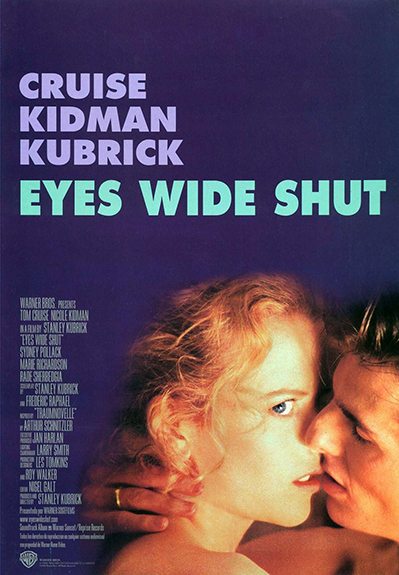

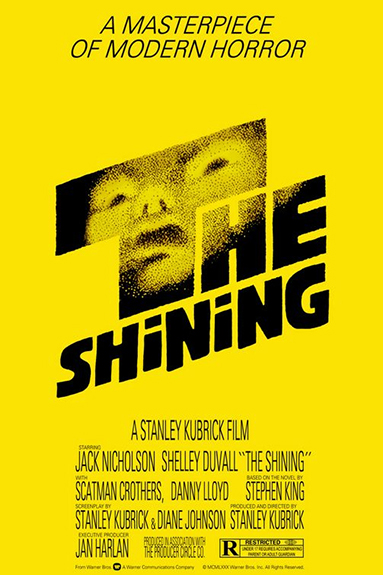
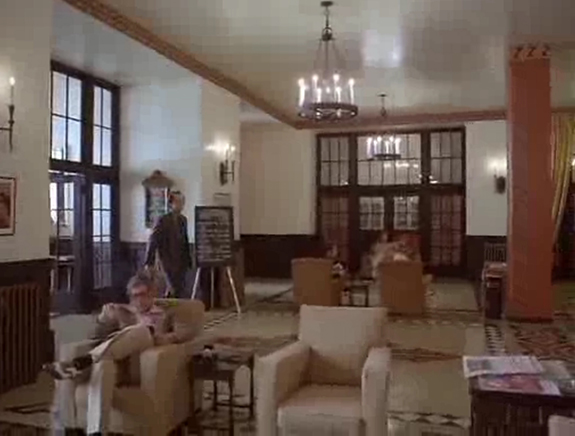
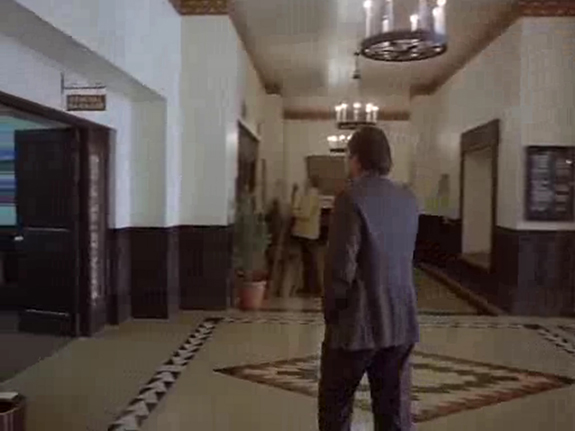
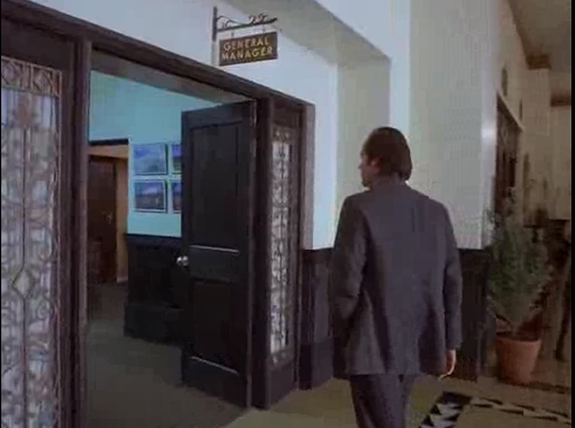

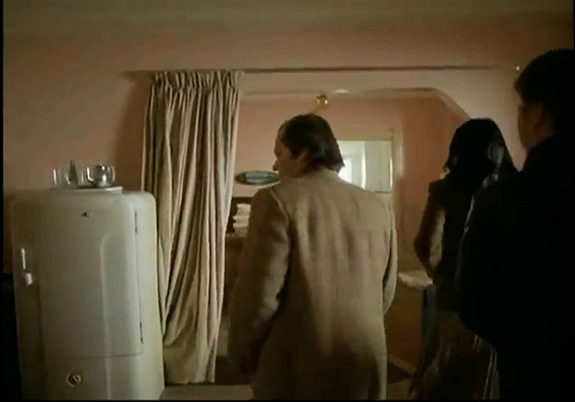

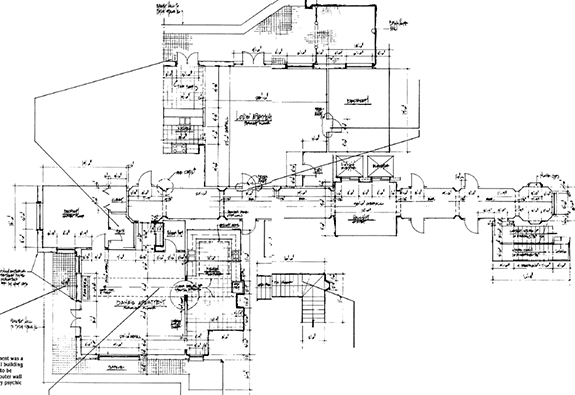
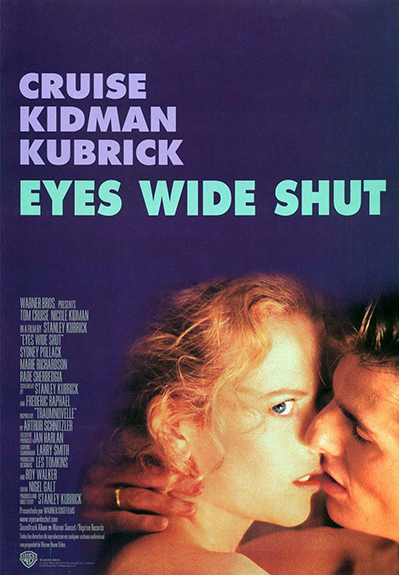
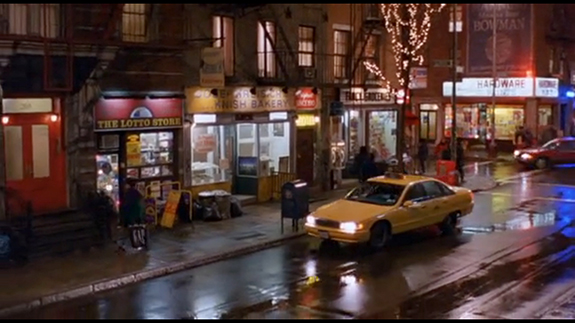


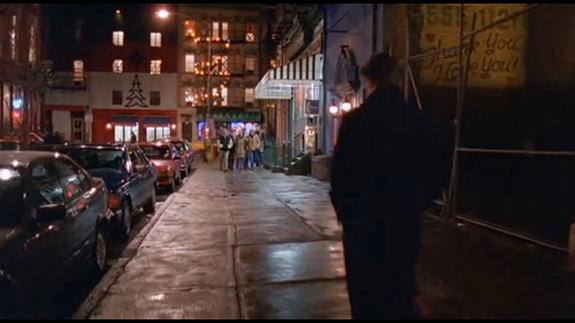
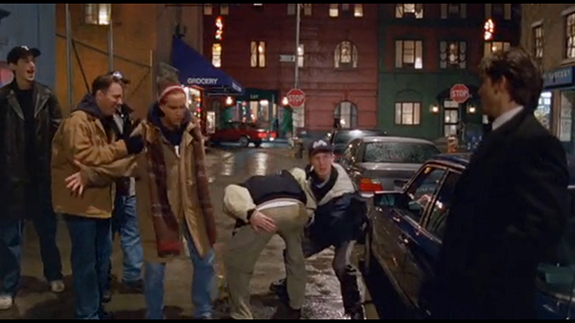
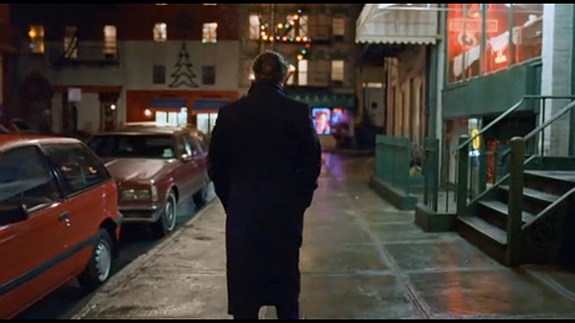
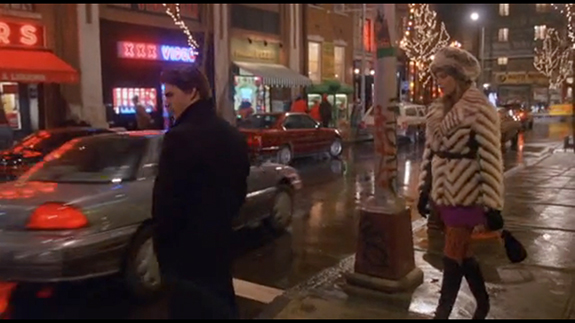
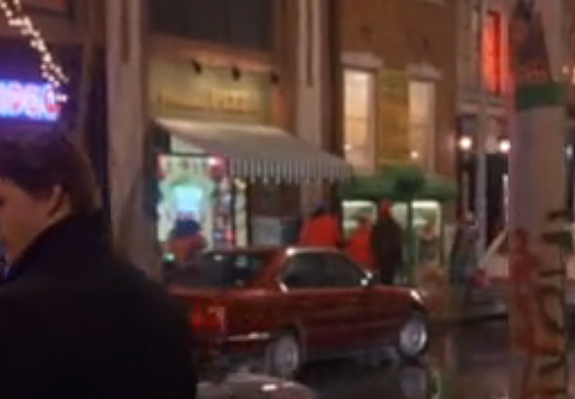


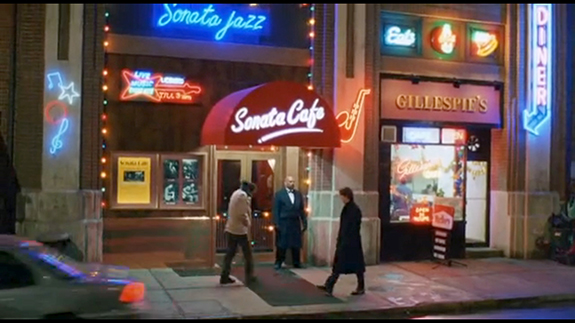
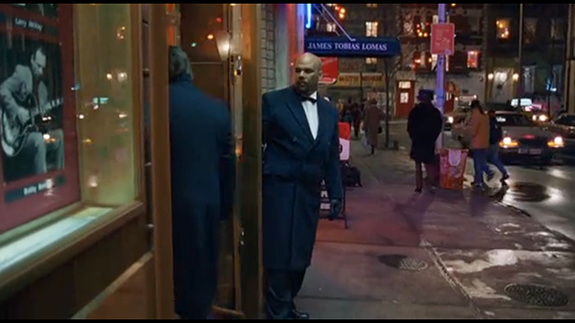
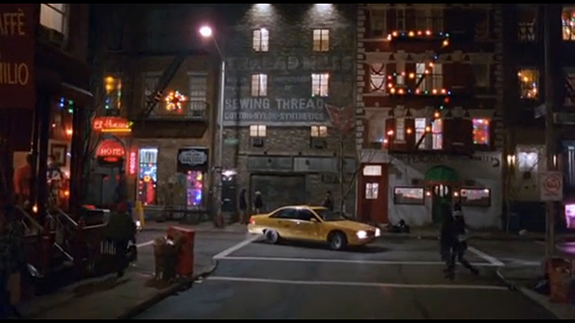
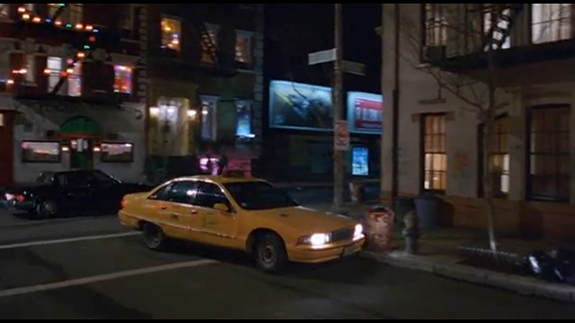



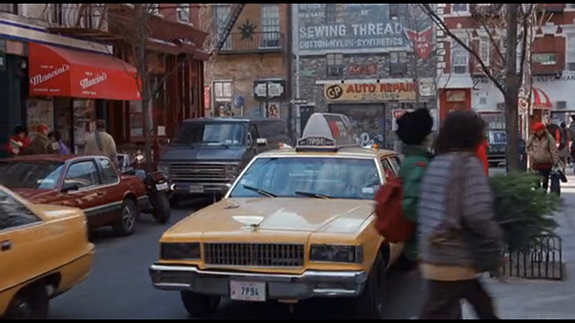


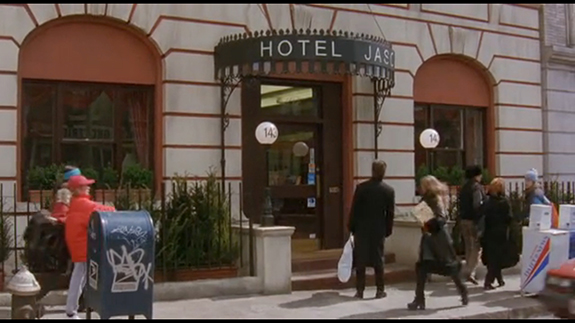


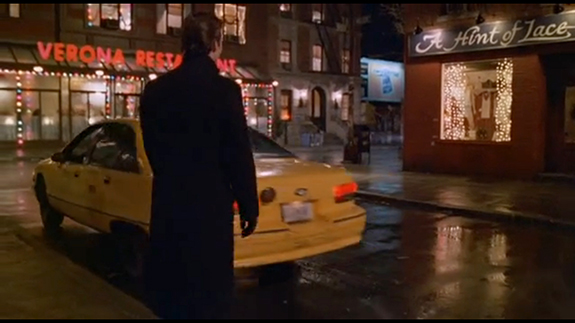
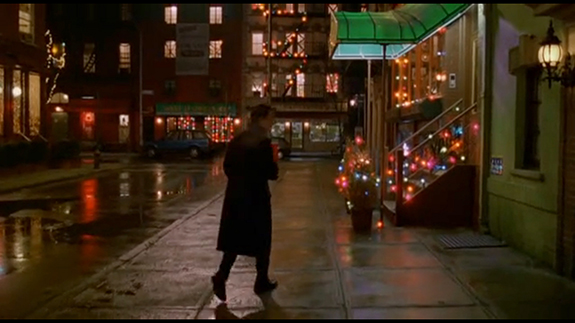
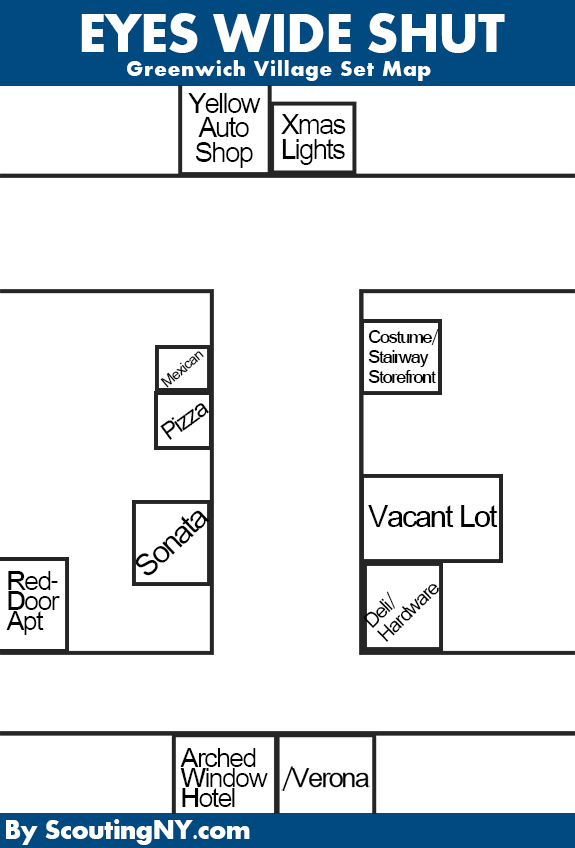

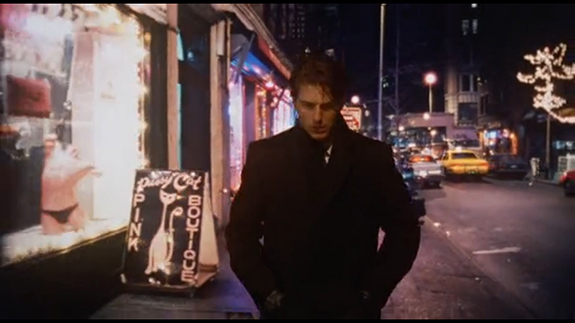
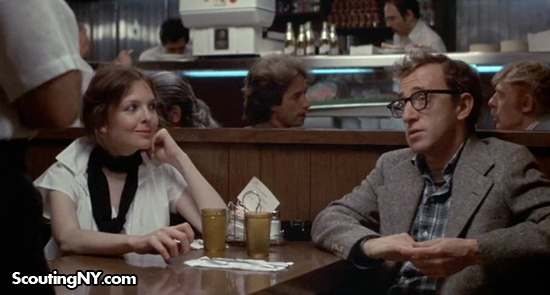
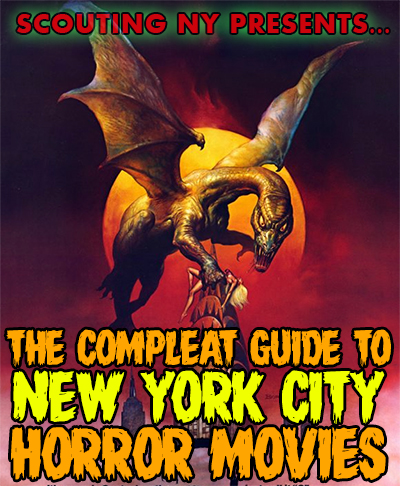
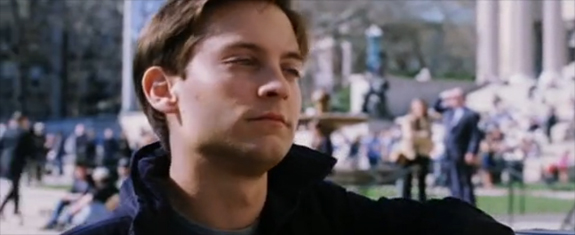


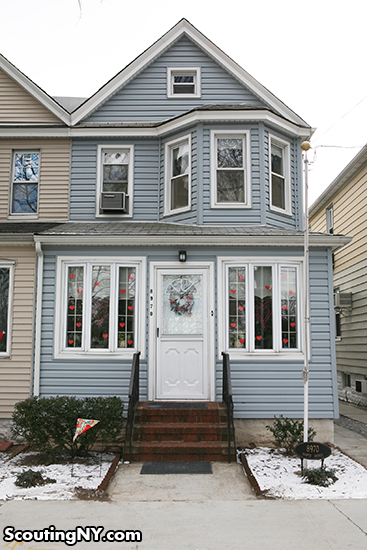
(real quick: love the post! the IFC Center in NY is having a Kubrick retrospective in anticipation of Room 237. i just saw Paths of Glory for the 1st time & it was the 35mm print version!)
in reply to the post, in the documentary Kubrick: Life in Pictures, they do mention the tone of the movie, and the intentionally dream-like feel of it. Kubrick knows that the lot doesn’t look like the real Greenwich Village. He’s ok with it because he wants it that way. Is Tom Cruise’s character in a dream, is this really happening to him? With the budget & time they had to make the movie (most scenes that would normally take a day to shoot, Kubrick sometimes extended to weeks even months to get what he wanted) i feel that looping, Matrix-esque feel could be very well, entirely deliberate. he took his time filming this movie. there was immense pressure to deliver & to satisfy his standards. i’m sure his production manager wouldn’t cut corners by repainting a facade when another set would have been adequate. however… with what the movie business is, you very well could be right, and this was just a clever way to save time & money and then chalked it up to a creative reason.
When Bill drives to the orgy mansion in daylight, he’s supposed to be on Long Island, but the types of trees and the look of the road itself clearly do not match. Once again, the scene was filmed near London.
Manhattan has very few T intersections of that ilk, so they’re always a giveaway of a backlot.
Wow, I had always thought it was filmed on a soundstage, because it feels so small. Or maybe because it’s so perfectly lighted.
ah, impressive investigation!!! i havent seen eyes wide shut, but all of a sudden, i’m intrigued to watch it.
Having worked with a few meticulous filmmakers, I am sure he said something more along the lines of, “This will make the fan boys go crazy figuring this out. they’ll be salivating thinking I chose it this way.” – and in reality “Is that all the money we have?”
It should be noted that quite a few of these exterior scenes were shot on the Paramount lot in LA. I did a tour there a few years ago and they took us around to show a few places with doors that were framed smaller to not make Tom look so short…
Considering Kubrick wouldn’t set foot on a plane, pretty sure those were actually imported for the lot tour.
Cruise was producing on the Paramount lot for many years, so you might be thinking of Vanilla Sky, or one of his other many LA productions.
Sorry, you’re mistaken. Nothing, not a single frame was film at Paramount Studios. It was all location filming and Pinewood Studios.
The biggest giveaway is that none of the street signs correspond to actual street in the Village; sort of like how in a dream we can’t really read text or numbers because they are always shifting.
You had me until the very end:
“PS – There’s one shot in Eyes Wide Shut that I was sure was filmed in New York – when Bill walks by the Village’s very real Pink Pussy Cat Boutique. But I was only half right. Look closely and you’ll see that Cruise is just walking in front of a rear projection that looks quite fake.”
You’re implying that Kubrick sucked at using CGI. This scene was reminiscent of the cab ride by Bruce Willis in “Pulp Fiction” or the Rex Kramer (Robert Stack) driving his convertible Mustang through a cowboy/indian shootout in “Airplane!” Obviously meant to be surreal, not bad CGI.
It wouldn’t have been CGI. It would either be green screen or rear projection where the background was actually shot and then added in. CGI they would have “made” the background. Not to mention CGI wasn’t very convincing at the time this came out.
Highly doubtful. Stop making excuses for bad film making.
This was an excellent break down, thank you very much. Ever since reading the article at the following link, I’ve been convinced that EWS may have indeed been one of Kubrick’s best films. It’s very long and detailed but very rewarding. His opening takedown of US “critical” opinion is terrific.
http://www.visual-memory.co.uk/amk/doc/0096.html
If it wasn’t clear in the article, I also really enjoy watching this movie.
I only saw this the one time in the theater, but I’m an architectural historian, so I notice the little details and found it maddening how Tom Hanks was supposed to be wandering all over lower Manhattan, when he was obviously (to me) just circling around on the same two tiny blocks of shopfronts.
It’s an effect that worked perfectly in Dark City, creating a threatening claustrophobia, but in this movie it just felt like a lack of verisimilitude.
(So many other details in this movie pegged it to England rather than New York that just seemed lazy and sloppy to me. I remember specifically the bathroom taps–clearly British. I suppose rich New Yorkers could have been persuaded by a decorator that British bathroom fixtures would be charming, but it was just one more detail in addition to all the others that made it clear some director or set designer was being lazy about the details.)
The tiny doorways in studio backlots have much less to do with making Tom Cruise appear taller than they do with forced=perspective. As with Disneyland, the buildings are built to some fraction of full-scale so that the appearance of a full-sized streetscape or town square can be given in less space with fewer materials. Watch Back to the Future and pay close attention to the background when Marty’s wandering around the Hill Valley town square–everything’s actually improbably small. Big 50’s cars pull up to tiny little service stations, the upper stories of buildings look too small to even inhabit…
On Kubrick set-mapping anomalies: I once tried to map the interior of the wheel (“carousel”) in 2001’s Discovery One spacecraft, piecing together the full 360 degrees of the floor plan. I found that in the famous jogging-around-the-wheel sequence, one or two of the shots are reversed — not filmed from an opposite angle but actual mirror images of the set as usually shown. I have no idea why this was done, maybe it was a crossing-the-line thing?
great article, but I can’t believe there is no mention of the recurring graffiti-tagged USPS mailbox that shows up several times throughout the film on different streets! it’s really quite distracting. eyes wide shut has always had such an embarrassingly obvious “backlot feel” to me that I just thought Kubrick was just getting lazy in his old age. 🙂
Can’t believe I missed that! Thanks for pointing it out.
The Shining is about colonialism, genocide and imperialism. These interpretations are not silly, nor are the sex abuse theories; Lolita anyone?
So is ‘The Amityville Horror’ the movie it ripped off!!
Similar to Raging Bull—Different size boxing rings throughout even the same fight!
I’ve always wondered why the New York set of Eyes Wide Shut seemed so lazy and unconvincing, especially because Kubrick was from the City and lived in Greenwich Village for years.
Maybe, after being away for 40 years, this is what he remembered New York as? Or maybe he just recreated the Bronx neighborhood of his youth, where sometimes streets do end, and all the buildings look the same?
Or maybe taking a decade off had simply left him a little rusty on the art of set building.
I had a show in production at Pinewood Studios when Eyes Wide Shut was filming. Kubrick’s New York exterior set was highly secure and you couldn’t get anywhere near it. But once the shooting was over, the guards disappeared along with the crew and no one prevented me from walking over and poking around. The set consisted of a couple of city blocks but here’s the thing that struck me — on at least 50% of the set, every single piece of signage was reversed. Store signs, street names, even graffiti. Without being party to the schedule, I assume that Kubrick took scenes on the streets dressed as normal and then the art department did a mirror-image redress, after which he shot more scenes and reversed the photographed image to get double value out of the same piece of real estate.
Eyes Wide Shut may have put Stanley Kubrick in his grave. He worked insanely long hours for months getting it ready, then died suddenly just before its release. While of course sudden deaths from heart disease in general are not rare, they _are_ relatively uncommon in a person of Kubrick’s age (70) with no known risk factors and no prior history. He really may have worked himself to death on the movie.
Peter: Kubrick smoked heavily for decades and, according to his wife, slept very little. That with limited physical activity and the insanely long hours for 2-3 years on EWS after a decade of not filming, certainly contributed to his death.
There were a few shots actually done in New York at Kubrick’s direction but without his presence. All second unit (like the Shining stuff that was shot on location). Malik Sayeed, a music video DP was hired and shot several things, mostly the wide shots of the cab driving to the Orgy mansion on Long Island. He’s credited in the film.
Impossible window placement on a set is one of my pet peeves. I see it all the time in television programs and it drives me crazy! As a set designer I can understand the need or want to have a window on the set, but that doesn’t make it right.
And while I’m airing my peeves, another one is props that keep reappearing in different locations. There was a sugar bowl in “Friends” that appeared on the set for just about every different location.
OK, I’m finished for now. I feel better, thank you.
Brilliant!! Always interesting.
This kind of analysis is ridiculous in my opinion. As a set designer of 20 years in features and commercials… the bottom line is almost always the same. As someone commented before: budget! Awnings and signage and even entire facades can be reused on another street so you’re not buying more of them… etc. They devised a manner to give Kubrick the amount of street he needed within their budget constraints. I know of almost no floor plan that makes logical sense… they’re designed for camera angles and studio parameters.
What’s so damn frustrating about this kind of analysis like in Room 239, is that is makes a great film feel trivial. Rather than concentrating on the emotional and psychological aspects of the movie and discussions about how they reflect the human condition… we’re culturally obsessed with facile conspiracy theories and silly minutia… and this spreads like a virus.
The only consolation is that his films will remain fascinating (for all the right reasons) long after all the silly critiques and facile film making analysis have died away.
For those who aren’t aware of the film making process… everything is a “cheat”. That’s the terminology. If you can get away with it and tell your story effectively… you do.
I totally agree with you here. Too many people analyze his films and I agree as a filmmaker of 10 years I can understand that the reason the set is a T junction is because of the budget (65 million to be exact) and the lack of space at Pinewood. All of which were contributors. Too bad so few people will listen to reason. And too bad more don’t just watch the movies and enjoy them
Kubrick is without a doubt very intelligent. Nobody can possibly argue that. The scope of his films is vast on multiple levels. I don;t think anyone can argue these points, however we can all argue his intent until the cows come home.
It’s been confirmed by the people close to him (as said above, his producer and also his wife) that he would intentionally play with the audience and was involved in every part of the film, i.e. the set design, props, and costumes. Now, I agree with all the people screaming “Budget!”. Kubrick was also known to love making a budget and strategizing how he could maximize his spending to make the most interesting film he could. Kubrick most definitely used the rotating set in Eyes Wide Shut to save money. But he does it in such a way that screams intent. It would not have been that expensive to build a less “looping” set. He could have built a couple extra sets and it would not have been very expensive when you think about the amount of days he spent shooting the film.
The best way to save on money for the film would have been to minimize the amount of days they had to pay Tom Cruise and all the extras. For example the Amanda Curran character is not in the film much but the actress was getting paid in England for the close to the entire shoot. When you think about that a couple extra sets doesn’t seem that expensive. Therefore, yes the set was done in this repeating, looping structure to save money but it was done in a specific fashion to make a deeper point about the character of Bill. The movie is based off the novella “Dream Story”. That should prove some intent right there even if the intent was also to save some money.
Also for those saying that Kubrick was lazy are just wrong. Would a lazy director spend 400 straight days making a film that potentially could have taken a few weeks to shoot? Laziness was not what was going here. Kubrick was looking for a certain quality from the performances in Eyes Wide Shut. He didn;t shoot it in New York because that would have been too hectic and rushed to make the kind of film he did with EWS. Yes it also was because he didn’t want to leave england, but Stanley treated the whole process of filmmaking as an art not just getting a film made as quickly as possible to move on to another.
Sorry, but it isn’t intentional. My dreams, even when weird have different images throughout. I don’t just keep on seeing the same buildings over and over. people are reading way too much into his films. Ask Jan Harlan if you want the truth, but it’s getting kinda tiresome hearing people calling the flaws intentional. The most important thing is that they are not even noticable – accept when people go looking and analyzing them!
Check out the scene with the hooker Mandy in Ziegler’s bathroom. Look at the table to her right and watch a Red Phone completely disappearand change to a table of drugs between cuts. Very noticeable even without looking for flaws frame by frame. http://somerton.tumblr.com/post/56050599500/red-phones
I’m also obviously not saying that film’s dream logic directly stands in for an actual human dream, but rather helps make sense of the internal logic of the film. I am also not saying the the events in EWS do not actually take place, but in a heightened sense of reality because that is essentially what a film is. Note how Bill doesn’t seem to think certain things are odd or out of place that the audience does, such as why the Masked girl knows he “doesn’t belong” at the orgy. He thinks the ritual is odd but he never questions how she knows he doesn’t belong. Bill nor Alice actually mention the Mask on the pillow at the end and Alice doesn’t even look at it. The mask on the pillow and Mandy knowing Bill are questions we the audience has but not the characters in the film.
You seem very sure of yourself that nothing Kubrick did in these situations was intentional. In the case of the greenwich village set I think it can serve a dual purpose of Budget and Artistic communication. I think Kubrick realized that in this case. You might disagree but surely the ideas of a continuous loop goes along with other Kubrick themes in The Shining and 2001. I believe that when Kubrick did something for financial reasons he made sure it worked for the film artistically as well or he found a different way to do it
Is this Bronx week? Kubrick is from the BX?
Hi,
The costume shop storefront is a replica of L’impasse at 29 West 8th street (in front of MacDougall) and the hotel is a replica of the Washington Square Hotel just around the corner at 103 Waverly Place.
Hi, I do think this is an excellent website. I stumbledupon it 😉 I will come back yet again since i have saved as
a favorite it. Money and freedom is the greatest
way to change, may you be rich and continue to guide other
people.
I actually worked on EWS for a day or two scouting newspaper holders, mailboxes and garbage cans…so the Wikipedia is correct….
really? Any other interesting info you can provide? I would love to talk to some of the extras and people with one or two lines to hear their point of view on what was going on during shooting
Remember that Kubrick died before this was released so other people had a hand in the final product.
Ultimately it is a matter of opinion. But if any of you here honestly believe that Kubrick chose to ‘screw up’ or go cheap on the sets, I believe you are mistaken. Cruise and Kidman agreed to do whatever Kubrick wanted, money was not an issue. As for production costs, money was no object. Kubrick just likes to screw with the audience’s mind in every way possible.
You might also note that when he returns to the mansion the next day in daylight, the trees are in the full bloom of summer, not pre-Christmas as they should be.
I also ran across this website by chance, and I find it to be endlessly fascinating. There is a tremendous satisfaction in scrutinizing your favorite movies, even if you’re just an armchair cineaste.
I would like to add one note on EWS that was vaguely alluded to above but I did not note anybody commenting on directly: regardless of budget constraints, and even if Kubrick sent a team of surveyors to Greenwich Village to measure everything, there is no going around that the set looked phoney. Any New Yorker can tell you that the Village doesn’t look like that – it was too manicured, the streets were too clean, and the sidewalks were so broad that it looked more like Toronto than New York. And Kubrick must have been aware of all this; as a native New Yorker he couldn’t help but be. And i all the years I lived in New York – and I was born there – I never, ever saw a kitchen with a built-in bathtub; at one time I am sure that they existed, but I doubt any were built that way after about 1890.
Just my two cents, for consideration.